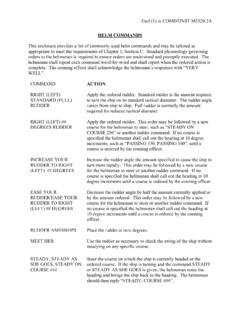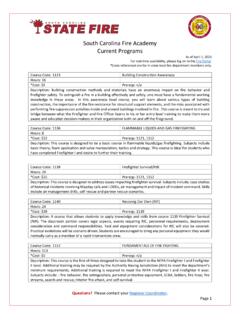Transcription of BOAT CREW HANDBOOK – Seamanship Fundamentals
1 BOAT CREW HANDBOOK Seamanship Fundamentals Bernard C. Webber, USCG BCH December 2017 Chief Warrant Officer Bernard Webber I reasoned I was a Coast Guard first class boatswain mate. My job was the sea and to save those in peril upon it. On 24 January 2009, Chief Warrant Officer (CWO) Bernard Challen Webber crossed the bar. During his 20-year career, CWO Webber was the recipient of the Gold Lifesaving Medal and responsible for one of the greatest small boat rescues in Coast Guard history. Born in Milton, MA, on 9 May 1928, Webber began his career at sea in 1944 when he joined the Merchant Marine.
2 After serving in the Pacific, he joined the Coast Guard in 1946. On 18 February, 1952, BM1 Webber was serving at the Chatham Lifeboat Station when a violent winter storm hit New England. Off the coast of Massachusetts, the SS Pendleton , a tanker originally built for the War Shipping Administration, was enroute from Baton Rouge, LA to Boston with a full load of kerosene and oil. At about 0550, in gale force winds, blinding snow and 60 foot seas, the vessel broke in two. In the bow, were the captain and seven crewmen. Thirty-three men remained in the stern section. There had been no time to issue an The stern section drifted south, about six miles off Cape Cod. The bow section was further offshore. As the men of Chatham Station were busy with the rescue of another tanker, radar picked up the two sections of Pendleton.
3 Visually sighted shortly thereafter, it became apparent that aid could only be rendered by use of the 36-foot Motor Life Boat CG-36500. Pendleton s stern section drifted close to shore. At 1755, BM1 Webber and three crewmen left the pier. As CG-36500 crossed Chatham s bar, massive waves tossed the small boat, shattering the windshield and tearing the compass from its mount. Knocked to the deck, Webber struggled to regain control. Several times, the engine died as the waves rolled the small vessel in the high seas. As both the weather and visibility worsened, Webber slowed CG-36500. The small searchlight finally revealed Pendleton s stern. Maneuvering his small boat around the mangled hulk, he saw men on the tanker s starboard quarter.
4 A Jacob s ladder was tossed over Pendleton s side and the surviving crewmembers started down the ladder. Webber moved CG-36500 closer and, one by one, the survivors jumped, landing in the lifeboat or in the sea where the crew assisted them to safety. Of the 33 men aboard the stern section, 32 were saved. With no compass to steer by, and in zero visibility conditions, Webber returned to Fish Pier and a cheering crowd. Initially told that he would receive the Gold Lifesaving Medal, and his crew lesser recognition, Webber refused. Finally, for their actions that day, BM1 Webber and his crew ( EN3 Ander Fitzgerald, SN Richard Livesey and SN Irving Maske) were awarded Gold Lifesaving Medals on 7 May 1952. A reluctant hero who disliked publicity, Webber remained in the Coast Guard, rising to the rank of Chief Warrant Officer.
5 His 20-year career included a tour off the coast of Vietnam during Operation Market Time. He retired in 1966. Immortalized by the Coast Guard, the cutter Bernard C. Webber (WPC-1101) was commissioned on 14 April 2012. BOAT CREW HANDBOOK Seamanship Fundamentals :BOAT CREW HANDBOOK Seamanship and survival Systems manual , COMDTINST (series) Crew HANDBOOK Boat Operations, PURPOSE. This HANDBOOK explains good Seamanship Fundamentals and how they apply to boat operations. Major topics within this HANDBOOK are Seamanship Fundamentals , Boat Characteristics, Stability, Weather and Oceanography, and Boat Handling. 2. DIRECTIVES AFFECTED. The Boat Crew Seamanship manual , COMDTINST , is DISCUSSION. The subjects and principles discussed herein include marlinespike Seamanship , boat characteristics, stability, weather and oceanography, and boat handling.
6 4. MAJOR CHANGES. First issue. 5. DISCLAIMER. This guidance is not a substitute for applicable legal requirements, nor is it itself a rule. It is intended to provide operational guidance for Coast Guard personnel and is not intended to nor does it impose legally-binding requirements on any party outside the Coast IMPACT ASSESSMENT. No impact assessment States Coast GuardUS Coast Guard Stop 73242703 Martin Luther King Jr Ave SEWashington DC 20593-7324 Staff Symbol: CG-731 Phone: (202) 372-2515 BCH 13, 2017 BCH ENVIRONMENTAL ASPECT AND IMPACT The development of this HANDBOOK and the general guidance contained within it have been thoroughly reviewed by the originating office in conjunction with the Office of Environmental Management, and are categorically excluded (CE) under current USCG CE #33 from further environmental analysis, in accordance with Section and Figure 2-1 of the National Environmental Policy Act Implementing Procedures and Policy for Considering Environmental Impacts, COMDTINST (series).
7 Because this HANDBOOK contains guidance documents that implement, without substantive change, the applicable Commandant Instruction and other guidance documents, Coast Guard categorical exclusion #33 is This HANDBOOK will not have any of the following: significant cumulative impacts on the human environment; substantial controversy or substantial change to existing environmental conditions; or inconsistencies with any Federal, State, or local laws or administrative determinations relating to the environment. All future specific actions resulting from the general guidance in this HANDBOOK shall be individually evaluated for compliance with the National Environmental Policy Act (NEPA), Department of Homeland Security (DHS) and Coast Guard NEPA policy, and compliance with all other environmental DISTRIBUTION.
8 No paper distribution will be made of this HANDBOOK . An electronic version will be located on the Office of Boat Forces (CG-731) Portal site: FORMS/ REPORTS. None9. REQUESTS FOR CHANGES. To recommend edits and changes to this HANDBOOK , please submit a formal request at the following link: BRIAN Coast GuardChief, Office of Boat signed by DN: c=US, o= Government, ou=DoD, ou=PKI, ou=USCG, cn= Date: 14:06:12 -05'00'Boat Crew HANDBOOK Seamanship Fundamental i Table of Contents CHAPTER 1 INTRODUCTION .. 1-1 SECTION A. PURPOSE OF THIS HANDBOOK .. 1-1 SECTION B. HOW TO USE THIS HANDBOOK .. 1-2 CHAPTER 2 MARLINSPIKE Seamanship .. 2-1 SECTION A. TYPES AND CHARACTERISTICS OF LINE .. 2-2 Line Characteristics .. 2-2 Composition .. 2- 2 Line .. 2- 2 Natural Fiber Line.
9 2-5 Composition .. 2- 5 Uses of Natural Fiber Line .. 2- 6 Limitations .. 2- 6 Construction .. 2- 6 Plain-Laid Lines .. 2- 6 Synthetic Fiber Line .. 2-7 Composition .. 2- 7 Commonly Used Types .. 2- 7 Double-Braided Nylon Line .. 2- 7 Plain-Laid Polypropylene Line .. 2- 8 Slippage .. 2- 8 Considerations .. 2- 8 Cutting .. 2- 9 SECTION B. INSPECTION, HANDLING, MAINTENANCE, AND STOWAGE OF LINE .. 2-10 Inspection .. 2-10 Description .. 2- 10 Aging .. 2- 11 Fiber Wear .. 2- 11 Fiber Damage .. 2- 11 Chafing .. 2- 11 Kinks .. 2- 12 Cockles .. 2- 12 Cutting .. 2- 12 Overloading or Shock-Loading .. 2- 13 Rust / Foreign Material .. 2- 13 Eye Splices (Double-Braided Nylon Line) .. 2- 13 Uncoiling and Unreeling .. 2-13 Description.
10 2- 13 Uncoiling Natural Fiber Laid Line .. 2- 14 Unreeling Synthetic Fiber Line .. 2- 14 Maintenance .. 2-15 Description .. 2- 15 Keeping Lines Clean .. 2- 15 Using Chafing Gear .. 2- 16 Keeping Deck Fittings Clean and Smooth .. 2- 16 Watching for Frozen Water .. 2- 16 Avoiding Crushing or Pinching Lines .. 2- 16 Being Cautious of Sharp Bends .. 2- 16 Care and Stowage of Natural Fiber Line .. 2- 17 Care of Synthetic Fiber Line .. 2- 18 Stowing Lines .. 2-18 Description .. 2- 18 Boat Crew HANDBOOK Seamanship Fundamentals ii Synthetic Fiber Lines .. 2- 18 Towline .. 2- 19 Coiling .. 2- 19 Flemishing a Line .. 2- 19 SECTION C. KNOTS AND SPLICES .. 2-20 Estimating the Length of a Line .. 2-20 Breaking Strength .. 2-21 Basic Knots.




![Welcome [rdept.cgaux.org]](/cache/preview/2/9/9/0/e/4/5/1/thumb-2990e451ec1a7a6f8f2bfac68b662858.jpg)


![Welcome [rdept.cgaux.org]](/cache/preview/c/3/d/e/b/6/f/6/thumb-c3deb6f6f41276aaa9c57d741cee6bc8.jpg)


